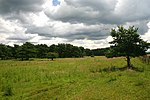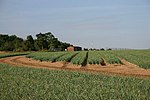How Hill Track
Sites of Special Scientific Interest in SuffolkSpecial Protection Areas in England

How Hill Track is a 3.1-hectare (7.7-acre) biological Site of Special Scientific Interest east of Mildenhall in Suffolk. It is in the Breckland Special Protection Area under the European Union Directive on the Conservation of Wild Birds.This is described by Natural England as a grassland site which provides suitable conditions for seven rare plants, including perennial knawel, small alison, purple-stem cat's tail and sickle medick.There is access to this site, which is now mainly woodland, from a footpath which runs along its southern edge.
Excerpt from the Wikipedia article How Hill Track (License: CC BY-SA 3.0, Authors, Images).How Hill Track
B1112, West Suffolk
Geographical coordinates (GPS) Address Nearby Places Show on map
Geographical coordinates (GPS)
| Latitude | Longitude |
|---|---|
| N 52.358 ° | E 0.573 ° |
Address
B1112
IP27 9BJ West Suffolk
England, United Kingdom
Open on Google Maps









